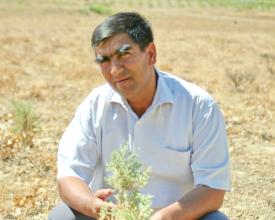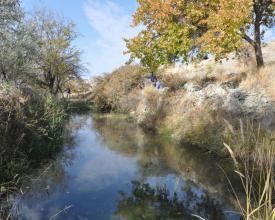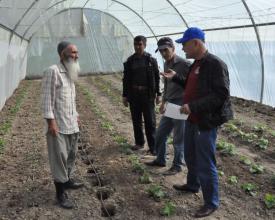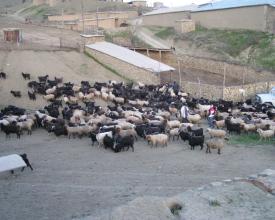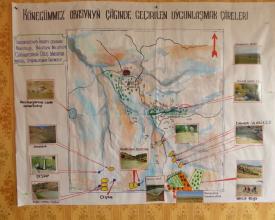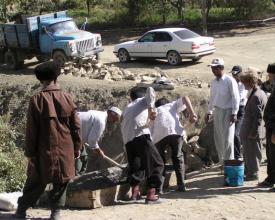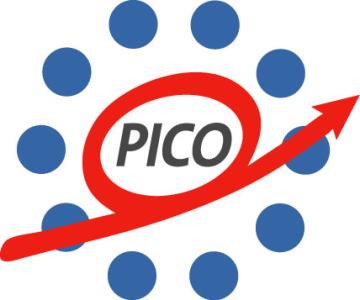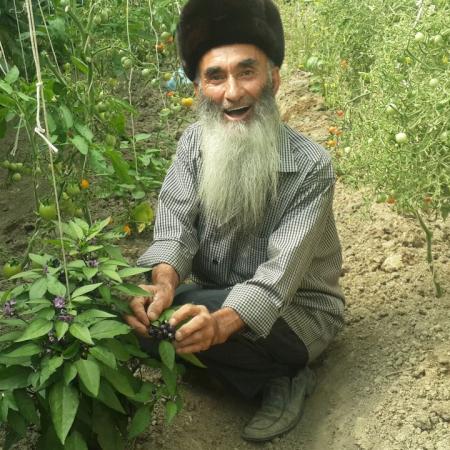
Gestión sostenible del uso de la tierra en el pueblo de Konegummez (Turkmenistán)
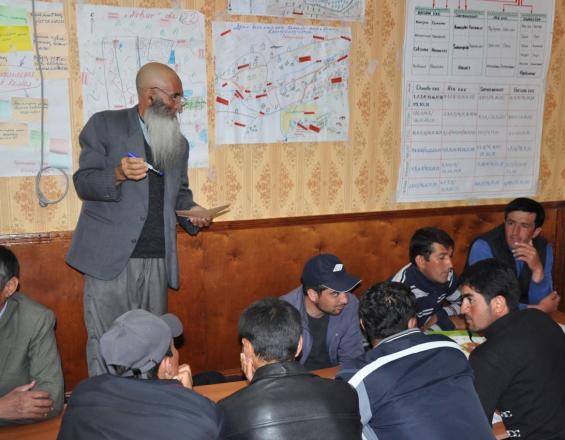
El pueblo de Konegummez está situado en la parte suroccidental de las montañas Kopetdag de Turkmenistán, en la frontera con Irán, a una altitud de 1.350 metros sobre el nivel del mar. La aldea acoge a 200 familias, con una población de unas 1.229 personas que viven en un clima semiárido y se ganan la vida con la ganadería y la agricultura, principalmente.
Basándose en la fuerza y la voluntad social de los aldeanos y con el apoyo de proyectos internacionales de desarrollo, hoy en día la aldea es un excelente ejemplo de planificación y gestión colectiva de los recursos naturales y la agricultura con mejores servicios ecosistémicos y biodiversidad, al tiempo que genera ingresos de forma sostenible.
A continuación se describirán los aspectos sociales, organizativos y técnicos que han llevado a la comunidad de Konegummez a tener éxito.
Contexto
Défis à relever
El pueblo de Konegummez está situado en una zona montañosa de clima semiárido. El agua siempre ha sido un recurso escaso, al igual que el suelo fértil para la agricultura.
Debido al fuerte crecimiento demográfico y ganadero, se han degradado los bosques naturales de enebro de la zona, que protegían el suelo y proporcionaban agua. También se han degradado considerablemente los pastos naturales. En 1930 vivían en el pueblo unos 150 habitantes con 800 cabezas de pequeños rumiantes y 100 cabezas de ganado. En la actualidad, viven en el pueblo 1.229 personas que poseen un total de 5.000 cabezas de pequeños rumiantes y 700 cabezas de ganado.
En estas condiciones, la población local tuvo que buscar formas de gestionar los pastos de forma sostenible, conservando y restaurando los bosques que quedaban, desarrollar técnicas de captación de agua y buscar otras fuentes de ingresos.
Ubicación
Procesar
Resumen del proceso
Todos los componentes forman parte de un enfoque sostenible e integrado de gestión del uso de la tierra. Por un lado, hay componentes "duros", como BB1, BB2 y BB3, centrados en la gestión de los recursos naturales, la agricultura y la ganadería. Por otro lado, hay dimensiones "blandas" del enfoque, relacionadas con el comportamiento de las personas, las interacciones y las relaciones socioculturales.
Los componentes "duros" no funcionan sin los "blandos". Los enfoques de gestión de la tierra que tienen éxito son aplicados por personas bien organizadas, motivadas y deseosas de aprender. Las personas y sus interacciones socioculturales son la base.
Bloques de construcción
Captación y gestión sostenibles del agua en zonas semiáridas, incluida la protección de los recursos naturales
El agua para el consumo doméstico como agua potable, así como para el riego en la agricultura y para abrevar el ganado, es un recurso básico y escaso en las zonas rurales de Turkmenistán. Por ello, en un clima semiárido, el agua es un fuerte motor para el desarrollo y la gestión sostenible del uso de la tierra.
En 1991, los habitantes de Konegummez pudieron construir su propio sistema de abastecimiento de agua. Se designó a una persona como mirab (responsable de la distribución equitativa del agua y de la supervisión de los calendarios de riego) para el posterior mantenimiento técnico del sistema.
Además, con la participación de organizaciones internacionales de desarrollo, en 2006 los aldeanos construyeron un pozo de agua para abastecer de agua a nuevas tierras agrícolas destinadas al cultivo de árboles frutales y hortalizas.
Hasta la fecha, el pueblo posee 4 pozos de agua y se han construido 5 presas de captación, en las que se han formado embalses con grandes volúmenes de agua. Estos embalses no sólo abastecen de agua a la población, sino que también sirven de abrevadero para el ganado.
Para proteger las fuentes de agua en las inmediaciones del pueblo, los aldeanos plantaron 10.000 enebros. En estos lugares de conservación, el pastoreo del ganado está fuertemente controlado. La medida ha ido acompañada de una importante reducción del número de cabezas de ganado.
Factores facilitadores
Debido al fuerte crecimiento de la población y al aumento del número de cabezas de ganado, se instó a los aldeanos a buscar soluciones relacionadas con el suministro de agua. Gracias a la clara articulación de sus necesidades y a la aportación de recursos propios, los aldeanos consiguieron el apoyo de organizaciones gubernamentales, así como de la cooperación internacional al desarrollo, para la recogida de agua y la adopción de medidas de gestión.
Lección aprendida
La principal lección aprendida fue que la captación y gestión del agua no puede tratarse como una cuestión aislada. Está entrelazada con la protección y restauración de los recursos naturales a nivel de paisaje, como los bosques naturales, así como con la gestión de las tierras productivas para fines agrícolas y ganaderos. Sólo si estas medidas se planifican y gestionan de forma combinada, la captación y gestión del agua tendrán éxito.
A nivel técnico, las lecciones aprendidas están relacionadas con la necesidad de establecer pozos de agua y cosechar agua superficial en embalses, para proporcionar agua suficiente a una población creciente, y a la ganadería y también a la producción agrícola diversificada.
Intensificar y diversificar la producción agrícola
En Konegummez la disponibilidad de tierras fértiles es limitada. Los agricultores cultivan hortalizas, como tomates, zanahorias, coles o patatas. Casi todas las familias poseen árboles frutales, como manzanos, albaricoques, nogales y almendros. La cosecha se destina primero al consumo familiar y el excedente se almacena para el invierno.
En 2014, los agricultores locales, con el apoyo de un proyecto, construyeron el primer invernadero (90 m²). El objetivo de la construcción de este invernadero era formar a los agricultores locales y adaptarse así a los efectos negativos del cambio climático. Al año siguiente, los agricultores construyeron por su cuenta otros tres invernaderos.
En una parcela arrendada de 33 hectáreas, los agricultores cultivan árboles frutales y hortalizas. Más de la mitad de la cosecha se vende. La parcela se riega por goteo, lo que garantiza un consumo de agua muy bajo.
En los campos de secano arrendados individualmente, los agricultores cultivan trigo por orden del gobierno. En estas parcelas, los ingresos agrícolas dependen del nivel de precipitaciones y, por lo tanto, varían mucho de un año a otro.
En general, en los últimos 15 años, las familias de agricultores han diversificado considerablemente su producción agrícola y la han hecho más resistente a los efectos negativos del cambio climático.
Factores facilitadores
El apoyo inicial al invernadero por parte de un proyecto de desarrollo internacional fue muy útil para proporcionar una tecnología innovadora en este ámbito. La gestión del invernadero y su valiosa demostración, así como las diferentes y nuevas formas de hortalizas, fue un factor muy importante para que los agricultores ganaran confianza en la nueva tecnología. El éxito de la venta de hortalizas y frutas en los mercados cercanos es un incentivo importante para las familias de agricultores.
Lección aprendida
La diversificación de la producción agrícola a mayor escala (en este caso, a nivel de aldea) depende de que haya gente interesada en probar algo nuevo. En el caso de Konegummez, el anciano y líder de la aldea actuó como "innovador". Este hecho combinó 2 factores de éxito: (1) disposición a probar cosas nuevas y (2) tener como "innovador" a una persona socialmente aceptada, mejor aún en una posición jerárquica superior, como en este caso el líder.
En el caso de las innovaciones costosas, como el invernadero, también parece importante que un actor, en este caso el proyecto de desarrollo internacional, que puede aportar recursos financieros, asuma el riesgo relacionado con un posible fracaso. Esto contribuye significativamente a que los agricultores pobres se impliquen en tecnologías innovadoras.
Gestión sostenible de pastos y ganado
La principal fuente de ingresos de los agricultores es el ganado. Cada año, cuando aumenta el número de pequeños rumiantes, se venden ovejas en el mercado o se destinan al consumo, para mantener la capacidad de carga de los pastos naturales. La venta de ovejas se realiza principalmente en verano. Para uso personal, los animales se sacrifican en otoño y se enlatan como reservas para el consumo hasta el otoño siguiente. En la actualidad, hay 4 rebaños de pequeños rumiantes en el pueblo, con un total de 5.000 cabezas, y 700 cabezas de ganado vacuno.
Además de los productos cárnicos, las familias de agricultores obtienen pequeños ingresos de la producción de queso local (de vaca y de cabra). Recientemente, la demanda de queso de cabra ha aumentado por la gente de los centros urbanos regionales que viaja al pueblo.
Recientemente, los propietarios de animales redujeron en un 30% (de 7.500 a 5.000) el número de pequeños rumiantes de sus rebaños. El número de animales lo controlan los bayars (agricultores elegidos con amplia experiencia en ganadería). Los bayars comprueban el número de animales cada dos meses y advierten a los propietarios para que reduzcan el número de cabezas de ganado si el rebaño supera las 1.000 cabezas. Al final de cada temporada, los ganaderos venden sus animales para reducir los rebaños a 800 cabezas. Los granjeros también empezaron a mejorar la raza del ganado, resistente al duro frío de las tierras altas.
Factores facilitadores
En las sociedades ganaderas, el número de cabezas de ganado no es sólo una cuestión económica, sino también de estatus social. Un número elevado de cabezas de ganado significa un estatus social elevado. Los ganaderos de Konegummez superaron esta trampa social, que conduce a la degradación de los recursos naturales. Los agricultores locales han desarrollado un mecanismo (el llamado bayar) que permite, de mutuo acuerdo, mantener un número de cabezas de ganado que responda a la capacidad de carga de los pastos. La mejor calidad del ganado ovino conlleva una menor susceptibilidad a las enfermedades y mejores precios de mercado.
Lección aprendida
Cambiar los modelos de cría de animales es un gran reto en las sociedades ganaderas. Requiere acuerdos sociales generalizados dentro de la sociedad, respaldados por los líderes de la comunidad, y sólo funcionará si
- los ganaderos obtienen un beneficio claro y tangible al reducir el número de cabezas de ganado;
- existen mecanismos claros y mutuamente acordados para controlar el número de cabezas de ganado.
Planificación conjunta y acción colectiva a nivel comunitario
El desarrollo de Konegummez se caracteriza por una fuerte acción colectiva. Organizándose, los miembros de la comunidad han conseguido animar a los organismos gubernamentales a proporcionar servicios básicos como, por ejemplo:
- De 1940 a 1960a: se crearon una escuela, una oficina de correos, una biblioteca, una tienda de comestibles, electricidad y el primer pozo de agua.
- En 1999 se gasificó el pueblo y en 2016 se asfaltó la carretera de acceso al pueblo.
- Los aldeanos construyeron ellos mismos 3 grandes puentes.
En la década de 2000, con el fin de gestionar de forma sostenible los recursos naturales y ocuparse de otros asuntos de la comunidad, se formó un comité informal integrado por 9 aldeanos. El grupo aprendió a identificar los retos y soluciones de la comunidad y a elaborar planes de acción. Cada año, el grupo elabora un plan de acción anual, que se socializa y finalmente se acuerda con los aldeanos. También hay una planificación a largo plazo, centrada en problemas de mayor envergadura.
Tras haber realizado una gran cantidad de trabajo de protección social y medioambiental en la comunidad, los aldeanos comprenden que deben seguir resolviendo los problemas mediante esfuerzos conjuntos. Han surgido líderes comunitarios que gozan de la confianza de los aldeanos. También existe un entendimiento mutuo con las autoridades locales y las organizaciones gubernamentales, que apoyan a las aldeas en la resolución de sus problemas.
Factores facilitadores
Los proyectos de desarrollo contribuyeron en gran medida al desarrollo de la autoorganización de la comunidad local. Los aldeanos no sólo recibieron ayuda económica, sino que también adquirieron conocimientos y aptitudes en materia de planificación, desarrollo del liderazgo, creación de asociaciones sociales, gestión sostenible de los pastos, adaptación al cambio climático, etc. No obstante, los habitantes de Konegummez ya tenían el "espíritu" de aprender y habían tenido en el pasado buenas experiencias de planificación, organización y ejecución del trabajo comunitario en común, la llamada "fuerza de la unidad".
Lección aprendida
Según los aldeanos, los proyectos internacionales les han ayudado a mirar el mundo desde otra perspectiva, a ampliar sus horizontes, a unirse aún más, a recaudar fondos y recursos para el desarrollo rural sostenible. La mayoría de los miembros del comité pudieron visitar Israel, Kazajstán, Tayikistán y Turquía e intercambiar experiencias y nuevos conocimientos y transmitirlos a sus compañeros de aldea.
Estos conocimientos los utilizan ahora para gestionar de forma sostenible los recursos naturales y proteger y rehabilitar sus bosques.
Combinar la cohesión social tradicional con nuevas formas de organización local
Konegummez recibe muchos servicios domésticos y ecosistémicos de los recursos naturales. Durante la Segunda Guerra Mundial, los aldeanos, a diferencia de otros, no pasaron hambre; la diligencia, la ayuda mutua, la organización, así como el trabajo duro y el amor por su tierra les ayudaron a sobrevivir en tiempos difíciles.
Desde la fundación de la aldea, sus habitantes no han dejado de emprender acciones colectivas, basadas en la confianza mutua y en la creencia de que "juntos somos fuertes". Con el tiempo, la fuerte cohesión social también ha "pagado" a los aldeanos. Estas experiencias positivas reforzaron la creencia de que "juntos somos fuertes" y motivaron a los aldeanos a aspirar siempre a nuevos horizontes y a seguir desarrollando su aldea.
Esa fue también la razón por la que pudieron crear un comité informal para planificar y gestionar de forma sostenible los recursos naturales de la aldea. El grupo está formado por un total de 9 personas: pastores, bayar, ancianos del pueblo, mirab, agricultores y un profesor.
Otro ejemplo de organización "moderna" está relacionado con la venta de productos agrícolas. Los agricultores han desarrollado un mecanismo de ahorro de recursos. Eligen entre sus propios aldeanos a una persona con un pequeño camión, que va al mercado y vende allí la cosecha de varios agricultores. De los ingresos recibidos, cada agricultor paga el 10%.
Factores facilitadores
Como ya se ha señalado, el factor más importante para la cohesión social y el buen funcionamiento de la organización local es el éxito que consiguen los vecinos organizándose. Se trata de un motor realmente potente para el desarrollo sostenible.
Lección aprendida
La cohesión social, la confianza mutua y un liderazgo fuerte son los pilares del desarrollo rural sostenible y pueden utilizarse independientemente de la cuestión de que se trate en diferentes contextos: por ejemplo, mejora de las infraestructuras, desarrollo económico local y uso sostenible de los recursos naturales.
Impactos
La gestión sostenible del uso de la tierra exige integrar aspectos socioculturales, ecológicos, económicos y técnicos para tener éxito. La aldea de Konegummez es un excelente ejemplo de cómo la integración de estos elementos puede funcionar en la práctica.
Los aldeanos han sido capaces de:
- Combinar formas tradicionales de organización local, como los bayars (residentes elegidos con amplia experiencia en ganadería) que controlan el número de cabezas de ganado y nuevos comités informales para planificar colectivamente la gestión de los pastos y la conservación de los recursos naturales.
- Planificar de forma consciente y colectiva el uso y la gestión de los recursos naturales y la agricultura, basándose en una planificación acordada y por escrito, seguida de un seguimiento.
- Restaurar y proteger los pastos naturales contra la degradación, reduciendo los ganaderos su cabaña en un 30% (de 7.500 a 5.000 cabezas de pequeños rumiantes) hasta un nivel sostenible.
- Emprender formas de agricultura alternativas e innovadoras para la zona, como, por ejemplo, el cultivo de hortalizas en invernaderos, el cultivo de árboles frutales con riego, la intensificación y concentración de la producción agrícola en parcelas más pequeñas.
- Captación y gestión sostenibles del agua: construcción de 4 pozos de agua de 130-140 metros de profundidad y 5 presas de captación, donde se han formado embalses con grandes volúmenes de agua, y reforestación mediante la plantación de 10.000 plantones de enebro en las laderas de las montañas.
Beneficiarios
Los beneficiarios de las medidas de gestión de la tierra desarrolladas son toda la población de la aldea de Konegummez, cuyas principales fuentes de ingresos son la ganadería y la agricultura.
Objetivos de Desarrollo Sostenible
Historia

En 2014, en la aldea, los agricultores locales, con el apoyo de un proyecto de desarrollo internacional, construyeron el primer invernadero con una superficie de base de 90 m². En la asamblea general de la aldea, se decidió nombrar al líder y anciano de la aldea, que goza de gran respeto entre la población, con la responsabilidad de gestionar el invernadero.
El objetivo de la construcción de este invernadero era formar a los agricultores locales en las particularidades del cultivo en invernadero, adaptándose así a los efectos negativos del cambio climático y reduciendo los posibles riesgos asociados. Según el anciano, el primer año se cultivaron en el invernadero pimiento, chile y tomates. El anciano distribuyó gratuitamente la cosecha entre los lugareños. Cuando se le preguntó por qué lo hacía, respondió que a su edad no necesita riquezas materiales, para él la riqueza más importante es el bienestar de sus compañeros de aldea. Si los vecinos entienden que construir un invernadero es importante, empezarán a construir invernaderos por sí mismos y así garantizarán el bienestar económico de sus familias y de sus compañeros de aldea proporcionándoles productos asequibles y sanos. Un año después de la primera cosecha del primer invernadero, se construyeron tres más en el pueblo y varios vecinos más empezaron a visitar al anciano para consultarle.


